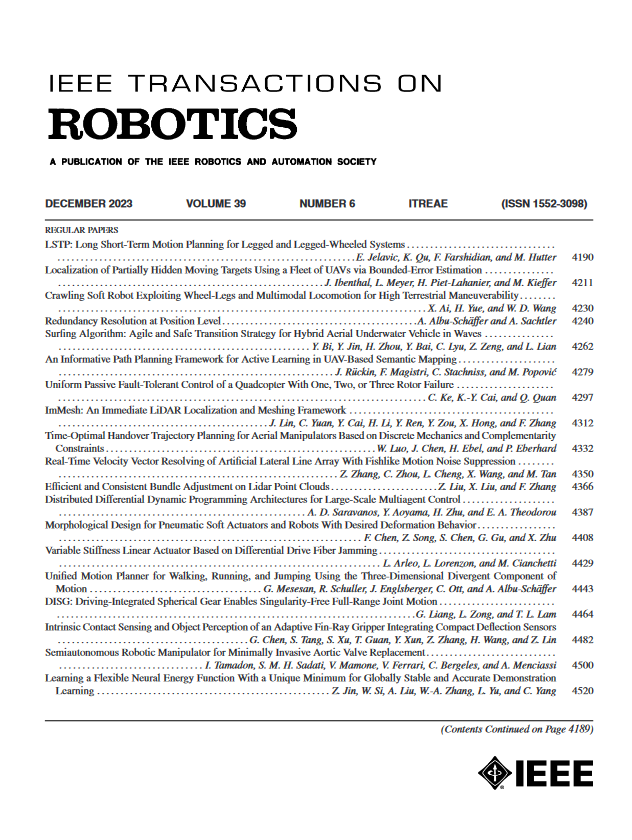Topo-Geometrically Distinct Path Computation Using Neighborhood-Augmented Graph, and Its Application to Path Planning for a Tethered Robot in 3-D
IF 9.4
1区 计算机科学
Q1 ROBOTICS
引用次数: 0
Abstract
Many robotics applications benefit from being able to compute multiple geodesic paths in a given configuration space. Existing paradigm is to use topological path planning, which can compute optimal paths in distinct topological classes. However, these methods usually require nontrivial geometric constructions, which are prohibitively expensive in 3-D, and are unable to distinguish between distinct topologically equivalent geodesics that are created due to high-cost/curvature regions or prismatic obstacles in 3-D. In this article, we propose an approach to compute利用邻域增强图进行拓扑-几何区分路径计算及其在三维系留机器人路径规划中的应用
许多机器人应用得益于能够在给定的配置空间中计算多个测地线路径。现有的模式是使用拓扑路径规划,可以在不同的拓扑类中计算最优路径。然而,这些方法通常需要非平凡的几何结构,这在3-D中是非常昂贵的,并且无法区分由于高成本/曲率区域或3-D中的棱镜障碍物而创建的不同拓扑等效测地线。在本文中,我们提出了一种使用新的邻域增强图的概念来计算k个测地线路径的方法,在这种方法上,图搜索算法可以计算拓扑几何上不同的多条最优路径。我们的方法不需要复杂的几何结构,所得到的路径也不局限于不同的拓扑类,这使得该算法适合于寻找和区分测地线路径的问题。我们演示了该算法在具有缆索长度约束的三维系留机器人的最短可穿越路径规划中的应用。
本文章由计算机程序翻译,如有差异,请以英文原文为准。
求助全文
约1分钟内获得全文
求助全文
来源期刊

IEEE Transactions on Robotics
工程技术-机器人学
CiteScore
14.90
自引率
5.10%
发文量
259
审稿时长
6.0 months
期刊介绍:
The IEEE Transactions on Robotics (T-RO) is dedicated to publishing fundamental papers covering all facets of robotics, drawing on interdisciplinary approaches from computer science, control systems, electrical engineering, mathematics, mechanical engineering, and beyond. From industrial applications to service and personal assistants, surgical operations to space, underwater, and remote exploration, robots and intelligent machines play pivotal roles across various domains, including entertainment, safety, search and rescue, military applications, agriculture, and intelligent vehicles.
Special emphasis is placed on intelligent machines and systems designed for unstructured environments, where a significant portion of the environment remains unknown and beyond direct sensing or control.
 求助内容:
求助内容: 应助结果提醒方式:
应助结果提醒方式:


